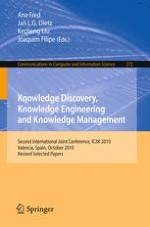This book constitutes the thoroughly refereed post-conference proceedings of the Second International Joint Conference on Knowledge Discovery, Knowledge Engineering, and Knowledge Management, IC3K 2010, held in Valencia, Spain, in October 2010. This book includes revised and extended versions of a strict selection of the best papers presented at the conference; 26 revised full papers together with 2 invited lectures were carefully reviewed and selected from 369 submissions. According to the three covered conferences KDIR 2010, KEOD 2010, and KMIS 2010, the papers are organized in topical sections on knowledge discovery and information retrieval, knowledge engineering and ontology development, and on knowledge management and information sharing.
